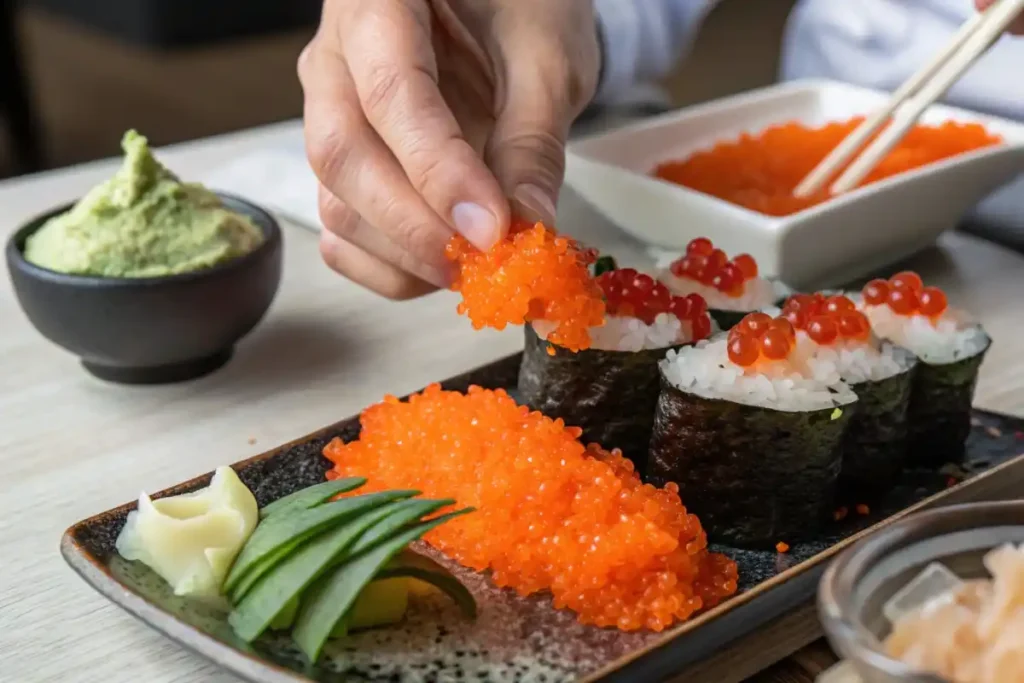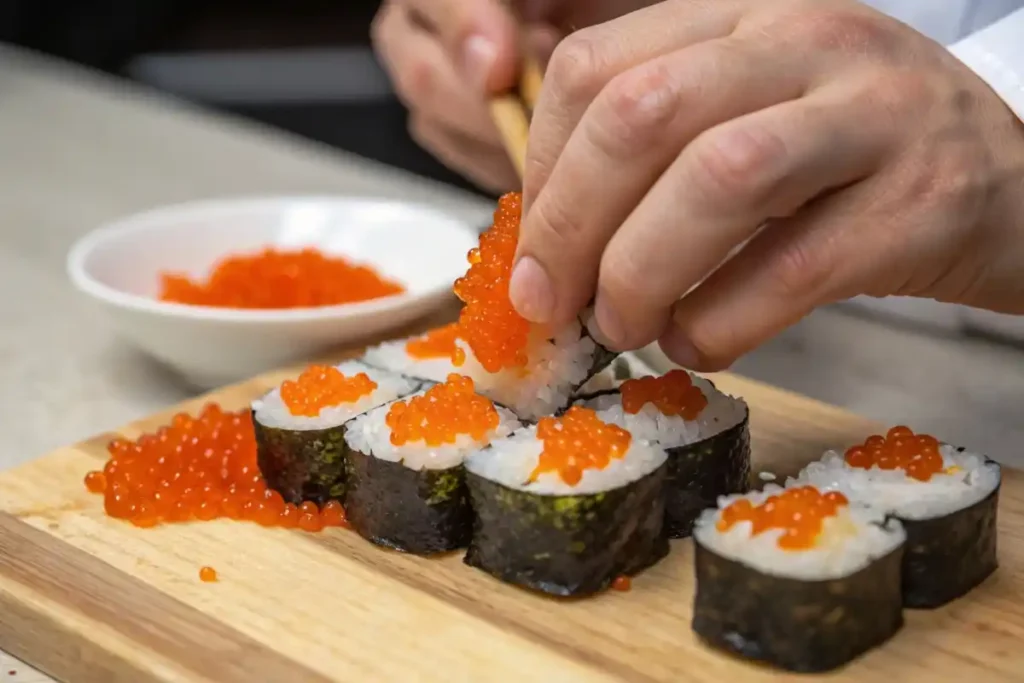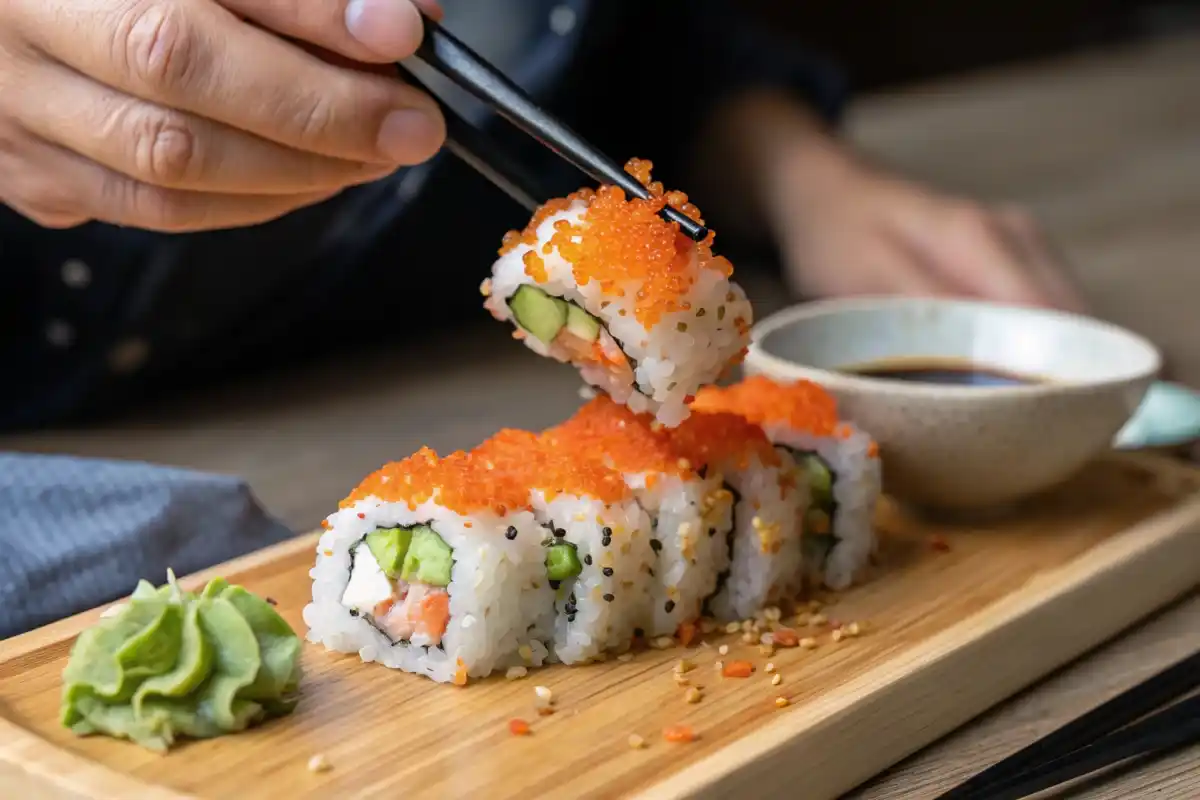Tobiko sushi is a delightful culinary experience that features tobiko, or flying fish roe, as a key ingredient. This article will explore the origins of tobiko, its unique flavor profile, how it compares to caviar, and its various uses in sushi and other dishes. Additionally, we’ll discuss where to buy tobiko and its health benefits.
Table of contents
1. Understanding Tobiko
What is Tobiko?
Tobiko refers to the roe of flying fish, and chefs often use it in Japanese cuisine, particularly in sushi. These tiny eggs typically measure less than 1 mm and come in vibrant colors like orange, red, and even black. Harvesters collect the unfertilized eggs and cure them in salt, which enhances their flavor. Often called “Japanese caviar,” tobiko adds a unique touch to various dishes, making it a popular choice among sushi lovers. Its small size and bright colors create visual appeal, adding a pop of excitement to any sushi roll.
Types of Tobiko
Tobiko comes in several varieties, each distinguished by color and flavor. The most common type, golden tobiko, gets its natural orange hue from simple curing with salt. Then there’s red tobiko, which producers often dye for aesthetic appeal, and green tobiko, flavored with wasabi for a spicy kick. Other types include black tobiko, which may have a nutty flavor from squid ink, and yellow tobiko, often infused with citrus flavors like yuzu. Each type brings its own unique taste and visual flair to sushi, enhancing the overall dining experience.

2. The Taste Profile of Tobiko
Flavor Characteristics
Tobiko offers a unique flavor that’s both salty and slightly sweet, making it a delightful addition to sushi. When you pop these tiny eggs in your mouth, you’ll notice a subtle crunch that adds texture to each bite. Moreover, the curing process often brings out a hint of citrus, which enhances the overall taste experience. This combination of flavors makes tobiko a versatile ingredient, complementing various sushi rolls and other dishes. Consequently, it’s not just about the taste; the vibrant colors of tobiko also make your meal visually appealing, adding to the enjoyment of dining.
Culinary Uses
Tobiko is primarily used as a topping for sushi, but its culinary applications extend far beyond that. You’ll often find it sprinkled on sashimi or mixed into sauces for an extra burst of flavor. Additionally, tobiko can be incorporated into salads, providing a delightful crunch and a pop of color. Some chefs even use it as a garnish for appetizers, showcasing its versatility. In fact, its ability to hold its shape makes it perfect for creative presentations, whether on a cracker or as part of a sophisticated dish. Thus, tobiko not only enhances flavor but also elevates the overall dining experience.
3. Tobiko vs. Caviar
Key Differences
Both tobiko and caviar are types of fish eggs, but they come from different species and exhibit distinct characteristics. Fishermen harvest tobiko from flying fish, while producers typically make caviar from sturgeon eggs. In terms of size, tobiko remains smaller and often boasts brighter colors compared to the larger, darker caviar. Moreover, caviar costs significantly more due to the overfishing of sturgeon, making tobiko a more accessible option for many sushi lovers. Consequently, while both can enhance gourmet dishes, tobiko offers a unique flavor profile that stands out on its own.
Culinary Roles
In the culinary world, tobiko and caviar serve different purposes. Chefs often regard caviar as a luxurious delicacy, typically enjoying it on its own or with minimal accompaniments. In contrast, sushi chefs frequently use tobiko as a supporting ingredient, enhancing the overall flavor without overpowering the main components. Additionally, tobiko’s vibrant colors and textures make it an excellent garnish, adding visual appeal to various dishes. Thus, while both types of roe have their place in fine dining, tobiko shines with its versatility and ability to complement a wide range of flavors.

4. How Tobiko is Made
Harvesting Process
The journey of tobiko starts with fishermen harvesting flying fish eggs. These fish typically inhabit warm ocean waters, where they lay their eggs. Fishermen collect the ripe, unfertilized eggs and then carefully process them. After they harvest the eggs, they cure them in salt to preserve freshness and enhance flavor. This crucial step not only keeps the eggs safe for consumption but also contributes to the unique taste that defines tobiko. Consequently, the quality of the harvesting and curing directly impacts the final product.
Coloring and Flavoring
You can find tobiko in various colors, achieved through natural or artificial means. For instance, producers cure golden tobiko simply with salt, while they dye red tobiko for visual appeal. Other colors, like green tobiko, get their spicy kick from wasabi. Additionally, chefs create black tobiko using squid ink, which gives it a distinct flavor and appearance. This ability to absorb colors and flavors makes tobiko a versatile ingredient in the culinary world. Thus, creative uses of colors and flavors not only enhance visual appeal but also deepen the taste experience.
5. Incorporating Tobiko in Sushi
Tobiko as a Topping
Tobiko is a popular topping for various sushi rolls, adding both flavor and texture. Its small size allows it to complement the other ingredients without overwhelming them. For example, you might find tobiko sprinkled on top of a California roll or used as a garnish for sashimi. Moreover, its vibrant colors make sushi visually appealing, enticing diners to try it. The combination of tobiko’s salty pop and the freshness of the fish creates a delightful balance, enhancing the overall sushi experience. Consequently, it’s a favorite among sushi chefs and enthusiasts alike.
Creative Uses in Other Dishes
Beyond sushi, tobiko can be creatively used in many other dishes. For instance, it can be mixed into sauces, providing a burst of flavor that elevates the dish. Additionally, tobiko can be added to salads, giving them a unique crunch and a splash of color. Some chefs even use it as a garnish for appetizers, showcasing its versatility. Furthermore, its ability to hold its shape makes it perfect for creative presentations, whether on a cracker or as part of a sophisticated dish. Thus, tobiko not only enhances flavor but also adds a touch of elegance to various culinary creations.
6. Where to Buy Tobiko
Shopping Tips
When looking to buy tobiko, your best bet is to visit specialty grocery stores or Asian markets. Many larger supermarkets, like Whole Foods, also carry tobiko in their seafood section. It’s important to check the packaging for freshness, as tobiko can spoil if not stored properly. Look for brands that clearly label their products and ensure they are refrigerated. Moreover, buying from reputable sources can help guarantee quality. If you’re unsure, don’t hesitate to ask staff for recommendations. Consequently, finding high-quality tobiko can enhance your culinary creations significantly.
Storage and Shelf Life
Once you’ve purchased tobiko, proper storage is key to maintaining its freshness. Keep it refrigerated and consume it within a few days after opening. If you have unopened tobiko, it can last for several weeks in the fridge, but always check the expiration date. Additionally, freezing tobiko is an option if you want to extend its shelf life. However, be aware that freezing may alter its texture slightly. Therefore, it’s best to use it fresh whenever possible to enjoy its full flavor and texture.
7. Health Benefits of Tobiko
Nutritional Value
Tobiko is not just a tasty addition to your meals; it also offers several health benefits. Rich in omega-3 fatty acids, it supports heart health and contributes to overall well-being. Moreover, tobiko contains essential vitamins and minerals, including vitamin B12, which is important for energy production and brain health. In addition, it’s low in calories, making it a great option for those looking to enjoy flavorful food without excessive calories. Consequently, incorporating tobiko into your diet can be both delicious and nutritious.
Is Tobiko Healthy?
While tobiko has many health benefits, moderation is key. It’s important to remember that tobiko is still a type of roe, which means it can be high in sodium due to the curing process. Therefore, if you’re watching your salt intake, it’s wise to enjoy tobiko in moderation. However, when consumed as part of a balanced diet, it can be a delightful and healthy addition to your meals. Overall, tobiko can be a flavorful way to enhance your dishes while providing nutritional benefits.
8. FAQs about Tobiko
Is tobiko actually fish eggs?
Yes, tobiko is indeed fish eggs, specifically the roe from flying fish. These tiny eggs are harvested and cured in salt, which enhances their flavor and preserves them for consumption. Often referred to as “Japanese caviar,” tobiko is popular in sushi and other dishes due to its vibrant colors and unique taste. The small size of the eggs, typically less than 1 mm, makes them a delightful addition to various culinary creations.
What does tobiko taste like?
Tobiko has a distinct flavor that is both salty and slightly sweet, with a hint of citrus. When you bite into these tiny eggs, they provide a satisfying pop, adding texture to your meal. The curing process contributes to its briny taste, making it a perfect complement to sushi and sashimi. Overall, tobiko enhances the flavor profile of dishes, making it a favorite among sushi lovers and chefs alike.
Is tobiko a caviar?
While tobiko is often compared to caviar, they come from different fish species. Tobiko is the roe of flying fish, whereas caviar is made from sturgeon eggs. Additionally, tobiko is smaller and typically brighter in color than traditional caviar. Although both are considered delicacies, tobiko is more affordable and widely used in Japanese cuisine, particularly in sushi dishes.
Is tobiko healthy?
Tobiko can be a healthy addition to your diet, as it is rich in omega-3 fatty acids, which are beneficial for heart health. It also contains essential vitamins and minerals, including vitamin B12. However, it’s important to consume tobiko in moderation due to its sodium content from the curing process. When enjoyed as part of a balanced diet, tobiko can provide both flavor and nutrition.
Conclusion
Tobiko sushi is a delightful culinary experience that showcases the unique flavors and textures of flying fish roe. With its vibrant colors and satisfying crunch, tobiko enhances various dishes, making it a favorite among sushi enthusiasts. Not only does it add visual appeal, but it also offers health benefits, including omega-3 fatty acids and essential vitamins. If you’re curious to learn more about tobiko, check out this informative article on Allrecipes. Additionally, for those looking to explore more about healthy recipes, read Delicious Rockfish Recipes: A Culinary Guide. Overall, incorporating tobiko into your meals can elevate your dining experience, providing both taste and nutrition. Whether you enjoy it in sushi or as a garnish, tobiko is a versatile ingredient worth trying.

